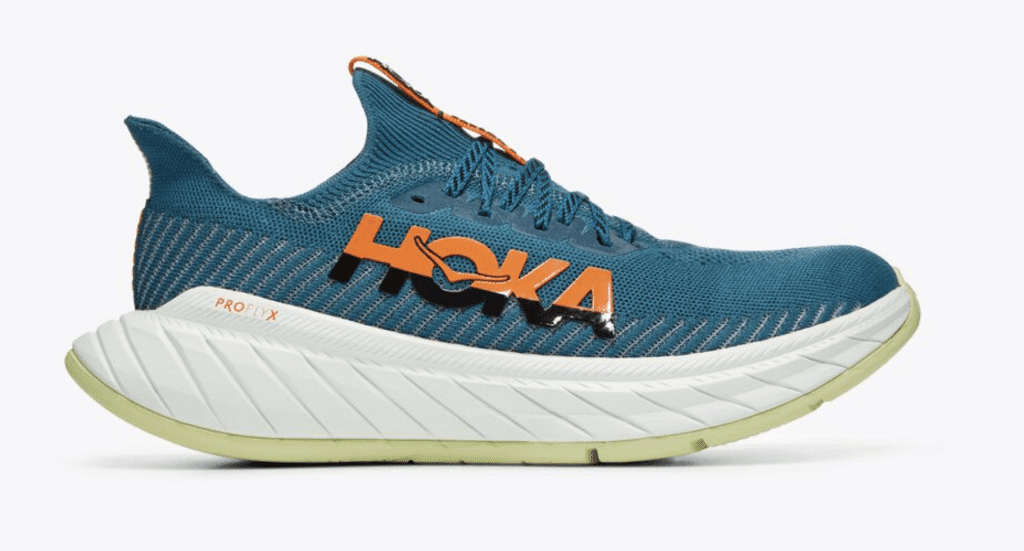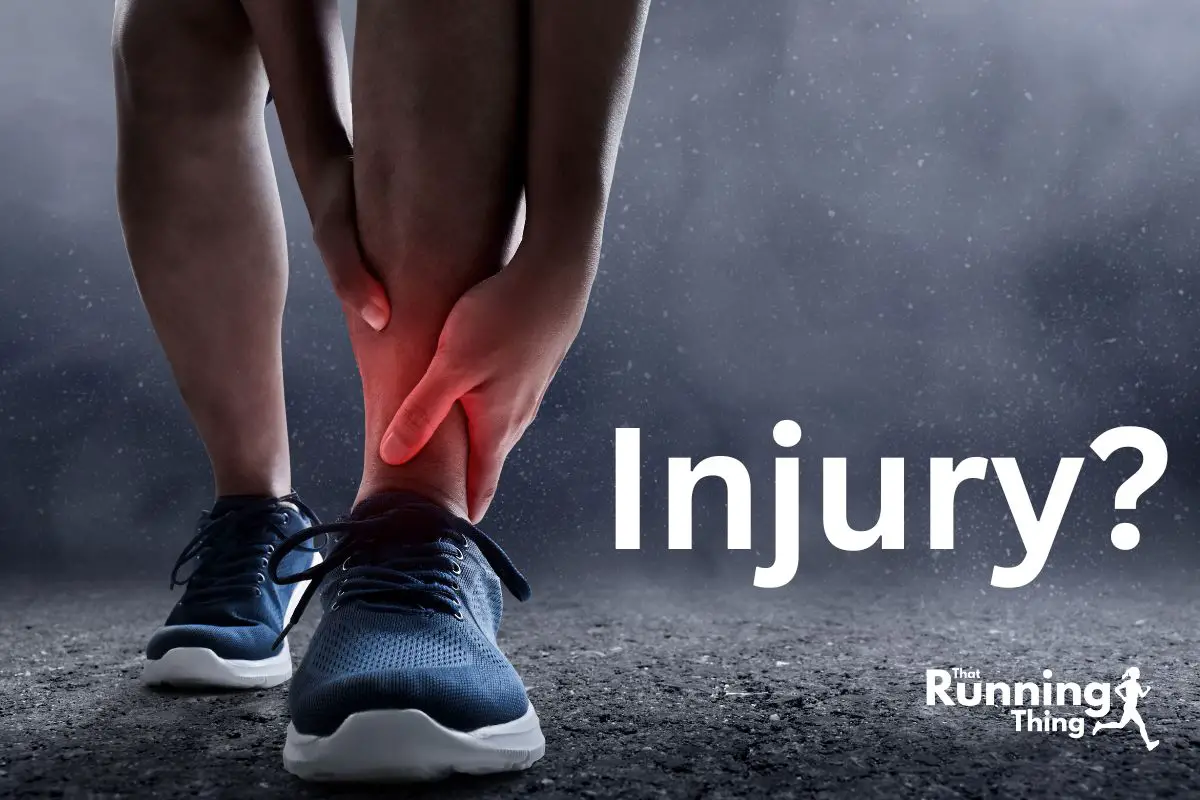You may have heard some runners talk about how carbon plate running shoes can cause an injury. That made you wonder if it would make sense to buy carbon plate since it costs more than regular running shoes. Carbon plate shoes lack the flexibility of traditional running shoes. Do carbon plate running shoes cause injury?

Running in carbon plate shoes won’t necessarily cause an injury, but it can increase your risk of an injury. The lack of flexion may lead to injury for some, especially untrained athletes. In truth, no conclusive evidence exists to suggest that they will definitely cause an injury.
Keep reading to explore why carbon plate shoes may cause injury and how to reduce your risk.
I explored the pros and cons of carbon plate running shoes in this post
To understand, you must know how the running dynamics change in carbon plate shoes. The carbon plate modifies how you land in the shoes. With each step, you spring back up, and the carbon plate alters the entire body movement. Many runners report larger calf muscles after using carbon plate due to it working a different set of muscles in the calves.
The extra rigidity, particularly for the ankle and feet, poses the biggest problem since they move differently. Training only in carbon plate can cause imbalances and irritation that develops into an injury. You may want to rotate between regular running shoes and carbon plate running shoes to reduce the risk.
Some argue that the carbon plate poses less risk of injury compared to when combined with highly cushioned shoes. The extra cushioning gives runners false confidence in how they run, which can cause the impact to be much harder on the pavement and the knees and feet. In truth, no one has confirmed whether carbon plate will cause an injury. You do want to take precautions when running in them, however.
What Injuries Could Carbon Plate Running Shoes Cause?
The most common injury that runners report with carbon plate has been overuse injury and plantar-related injuries. Most runners increase their risk if they use the carbon plate running shoes too much. Plantar fasciitis won’t end your running career, but you will need extra cushioning in your shoes to prevent aggravating the problem.
One of the biggest reasons that carbon plate aggravates the plantar comes from the lack of movement in the shoe and the Achilles. Running, in general, sees issues with plantar fasciitis.
What Injuries Does Carbon Plate Prevent?
Previously, I spoke about how carbon plate may prevent some types of injuries, but I didn’t talk too much about the injuries that it could stop. Keep in mind that all of this remains non-conclusive, so I wouldn’t buy carbon plate shoes thinking that it will definitely prevent an injury. It has the potential to do this, but you can’t say for sure either way.
Some of the injuries that carbon plate may prevent include:
- Chronic knee injuries
- Chronic hip injuries
- Chronic ankle injuries
- Repetitive stress injuries
One study found that the knee joints perform less work in carbon plate shoes. This is because of less reliance on muscles from the knee for propulsion. Some researchers even believe that you may be able to use running shoes to reduce the risk of chronic knee pain from running. This problem has become so widespread that they even termed it runner’s knee.
How to Know if the Carbon Plate Running Shoes Work for You
I would consider carbon plate running shoes as more of preference where some runners will love them and others will prefer regular running shoes. Ask yourself if you can run fast enough to see the benefits. Many beginners runners don’t run fast enough to see a huge benefit from carbon plate. You would do better to refine your form to get the running speed improvements. In this post, I consider if you should train in carbon running shoes.
Think about if the improvements will be enough to merit the cost.
Second, ask yourself if you have the budget for carbon plate running shoes since they cost double to regular running shoes. If that weren’t enough, they wear out at 155 to 186 miles on average. Compare it to regular running shoes, they normally last anywhere from 300 to 500 miles, depending on the brand. For a beginner, regular running shoes will usually be enough.
Next, you have to think about your own body. Do you have a structural issue that could increase the risk of an injury? Some runners may have an increased risk from using carbon plate, but you need to decide for yourself.
When searching for carbon plate running shoes, like with regular shoes, you should consider what suits your own biomechanics the best. Someone prone to running injuries may want to choose regular running shoes to stay on the safe side. If they hurt when running, swap them for another pair of shoes.
Once again, consider reading my post on the pros and cons of carbon plate running shoes
Less Well-Trained Athletes Most at Risk
Carbon plate running shoes weren’t made for the beginner in most cases, and it can often lead to injuries when you use them incorrectly. Slower runners won’t get the full benefit of carbon plate running shoes since it won’t increase their speed as much.
Weakening the Feet, More Vulnerable to Injury?
Some believe that carbon plate running shoes will make your feet weaker. The argument about weakening the feet goes back decades due to it overprotecting the feet. Having feet that work less may not be a good thing since the muscles in the feet will weaken from atrophy. No one can confirm the long-term negative effects of carbon plate shoes.
They make the same argument about shoes that provide more cushioning, and how it may, in fact, expose you to a higher risk of injury due to overconfidence. For anyone who suspects that carbon plate might weaken the feet, one of the ways that they can get around this is by rotating their shoes out. The rotation has an additional advantage in that it trains all the muscles in the foot and varies it up.
You do have an argument for this being true. For example, we know that other shoes can make our feet weaker. The biggest issue from the carbon plate running shoes comes from how it doesn’t let you move all your joints and ligaments.
Do carbon-plated shoes hurt feet?
Carbon plate shoes could potentially hurt your feet, but it depends more on the shoe brand than the carbon plate. With whatever shoe you buy, you want to make sure that it supports your feet in the right ways to prevent pain. Some who wear carbon plate even report feeling better after a workout.
What does carbon do in running shoes?
The carbon plate in running shoes was designed to add greater spring to your steps to propel you forward faster and increase your running speed. Faster runners see the most benefit from carbon plates, but it can help with running fatigue over long distances. It does this by enhancing energy return.
How do you break in carbon plate running shoes?
Most running experts recommend that you break in carbon plate running shoes about two weeks before your big race. Do it in the final weeks of training since carbon plate shoes will break down faster than normal shoes. You don’t want to wear them toward the end of their lifespan for the big race.
What are the best running shoes for injury recovery?
Choose a pair of shoes after an injury carefully since it determines how well you recover. What feels right to one may cause the next to further injure themselves. You must think of it as more of an individual pursuit. To find the right shoe, look for what feels the most comfortable to wear.
Final Thoughts
No definite evidence exists, either way, to suggest that carbon plate running shoes will cause injury. Most runners air on the side of caution with them and use them in rotation with their regular running shoes to prevent injuries. Overuse is the greatest danger that you can suffer from when using them.
If I had to make a recommendation for a great pair of carbon plate running shoes, I would recommend the Nike Men’s Air Zoom Alphafly Next or the Brooks Hyperion Elite 3.
(available for men and women).


